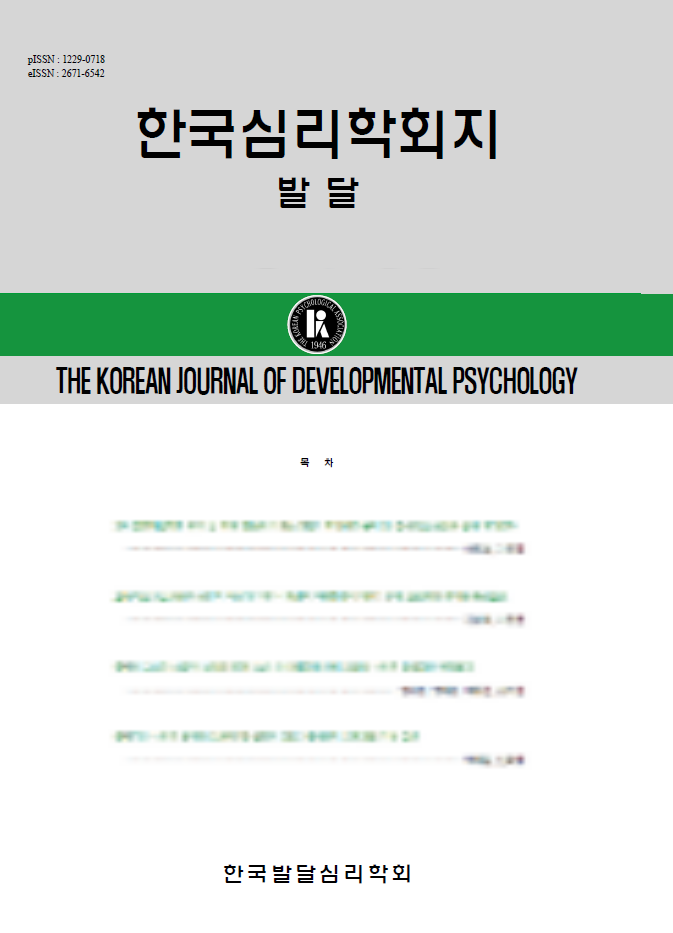open access
메뉴
open access
메뉴 ISSN : 1229-0718
ISSN : 1229-0718
This study examined the mediating effects of parents' self-compassion and self-coldness on the problematic behavior of school-age children through marital satisfaction, warm and accepting parenting behavior. Data were collected from 336 married men and women with elementary school children in grades 4 to 6. The results of the study are as follows. First, the mediating effects of both parents’ self-compassion and self-coldness on children’s problematic behavior through marital satisfaction were not significant. Second, only parents' self-compassion had a significant partial mediating effect on their children's problematic behavior through warm and accepting parenting behaviors. Third, in the relationship between parents' self-compassion, self-coldness and children’s problematic behavior, the sequential mediating effect of marital satisfaction and warm and accepting parenting behaviors was significant. This study is meaningful because it examined the overall influence of parents’ personal characteristics on the family by distinguishing between self-coldness and self-compassion. The study’s results can serve as a theoretical basis for parental education programs incorporating self-compassion.
school-aged This study examined the relationship between parents’ adult attachment (anxiety and avoidance) and growth after adversity, in parents of school-aged children with developmental disabilities via parenting efficacy and disability acceptance. Self-report data of 152 parents of 6-12 years old children with developmental disabilities were analyzed using the SPSS 28.0 and process macro. The results indicated the significant dual mediating effects of parenting efficacy and disability acceptance. First, the relationship between parent’s adult attachment, growth after adversity, parental efficacy, and disability acceptance of children with school-aged developmental disabilities, a negative correlation was found between parental attachment and growth after adversity. Additionally, a negative correlation was found between parental attachment and parental efficacy. However, among parents’ adult attachments, unlike anxiety attachment, avoidant attachment had a negative correlation with parental efficacy. Contrarily, parental efficacy was found to be corelated with growth after adversity and disability acceptance. Second, among the attachments of parents of school-aged children with developmental disabilities, the dual mediating effects of parental efficacy and disability acceptance were confirmed in the relationship between avoidant attachment and growth after adversity. These findings provide a theoretical foundation to support the growth after adversity of parents of school-aged children with developmental disabilities.with developmental disabilities, Adult attachment, growth after adversity, parental efficacy, disability acceptance
Adults raised in East Asian cultures exhibit holistic attentional biases, focusing more on contextual information such as the background, compared to adults from North American cultures, who prioritize the foreground. Caregivers were observed to transmit these biases to the children. This study explored the cultural tendencies and attentional biases of caregivers in the rapidly changing Korean cultural context, and whether these tendencies and biases influenced the relational reasoning performance of their children aged 18 to 36 months. Analyses of 83 mothers showed that Korean mothers valued both individualism and horizontal collectivism but they emphasized the foreground over the background in scene descriptions, reflecting analytic attentional biases. However, no apparent influence of maternal cultural tendencies was observed in their child’s relational reasoning performance, suggesting that cultural influences may not yet play a direct role in development at this early stage.
This study examined the mediating role of anger in the relationship between parental psychological control and dating violence perpetration, while also investigating the moderating effects of perceived power in relationships and gender. Women reported higher perceived power in relationships than men, but no gender differences were found in overall dating violence perpetration. Additionally, moderated mediation effects of perceived power and gender were significant. For men, parental psychological control influenced dating violence perpetration through anger, regardless of their perceived power in relationships. In contrast, for women, this indirect effect was significant only when their perceived power in relationships was below average and was not significant when it was above average. The findings highlight the importance of intrapersonal, environmental, and interpersonal factors in explaining dating violence and emphasize the need for gender-specific interventions.
Focusing on the overlap and dynamics of bullying experiences during adolescence, this study investigated the developmental patterns and characteristics of verbal, relational, and physical bullying experiences among Korean adolescents. A latent transition analysis was conducted on the data of 2,498 participants in the elementary panel of the Seoul Education Longitudinal Study. The results of the analysis are as follows. First, we found five types of school-violence experiences in adolescence: uninvolved, aggressors, victims, verbally aggressive victims, and verbal-relational-physical aggressive victims. Second, we found that the proportion of the uninvolved group increases rapidly as the grade level increases. Third, we identified sex differences and protective factors against bullying. Based on these findings, the implications and limitations of this study are discussed.
This study examined how questions influence the exploratory behavior of Korean children aged 3-5 years. Children explored a novel toy after hearing either direct instructions from a knowledgeable informant (direct instruction condition) or questions posed by an informant who was either knowledgeable or ignorant of the toy (pedagogical- or information-seeking question conditions). Children in the question conditions explored more functions of the toy and performed more unique behaviors than those in the direct instruction condition. However, no significant differences were found between the pedagogical and information-seeking question conditions. These results suggest that both educationally intended and simply information-seeking questions can effectively promote children’s exploration. Additionally, children with higher sensitivity and openness exhibited more unique behaviors, emphasizing the role of temperament in their exploration.